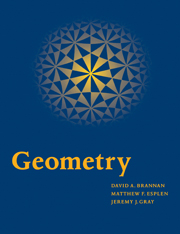Book contents
- Frontmatter
- Contents
- preface
- Introduction: Geometry and Geometries
- 1 Conics
- 2 Affine Geometry
- 3 Projective Geometry: Lines
- 4 Projective Geometry: conics
- 5 Inversive Geometry
- 6 Non-Euclidean Geometry
- 7 Spherical Geometry
- 8 The Kleinian View of Geometry
- Appendix 1 A Primer of Group Theory
- Appendix 2 A Primer of Vectors and Vector Spaces
- Appendix 3 Solutions to the Problems
- Index
Introduction: Geometry and Geometries
Published online by Cambridge University Press: 05 June 2012
- Frontmatter
- Contents
- preface
- Introduction: Geometry and Geometries
- 1 Conics
- 2 Affine Geometry
- 3 Projective Geometry: Lines
- 4 Projective Geometry: conics
- 5 Inversive Geometry
- 6 Non-Euclidean Geometry
- 7 Spherical Geometry
- 8 The Kleinian View of Geometry
- Appendix 1 A Primer of Group Theory
- Appendix 2 A Primer of Vectors and Vector Spaces
- Appendix 3 Solutions to the Problems
- Index
Summary
Geometry is the study of shape. It takes its name from the Greek belief that geometry began with Egyptian surveyors of two or three millennia ago measuring the Earth, or at least the fertile expanse of it that was annually flooded by the Nile.
The word comes from the Greek words geo (Earth) and metria (measuring).
It rapidly became more ambitious. Classical Greek geometry, called Euclidean geometry after Euclid, who organized an extensive collection of theorems into a definitive text, was regarded by all in the early modern world as the true geometry of space. Isaac Newton used it to formulate his Principia, the book that first set out the theory of gravity. Until the mid-19th Century, Euclidean geometry was regarded as one of the highest points of rational thought, as a foundation for practical mathematics as well as advanced science, and as a logical system splendidly adapted for the training of the mind. We shall see in this book that by the 1850s geometry had evolved considerably -indeed, whole new geometries had been discovered.
Euclid was a Greek mathematician of the 3rd century BC.
The idea of using coordinates in geometry can be traced back to Apollonius's treatment of conic sections, written a generation after Euclid. But their use in a systematic way with a view to simplifying the treatment of geometry is really due to Fermat and Descartes. Fermat showed how to obtain an equation in two variables to describe a conic or a straight line in 1636, but his work was only published posthumously in 1679.
- Type
- Chapter
- Information
- Geometry , pp. 1 - 4Publisher: Cambridge University PressPrint publication year: 1999



